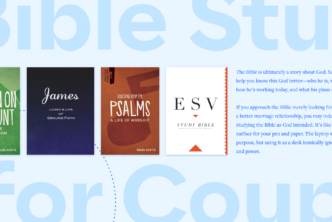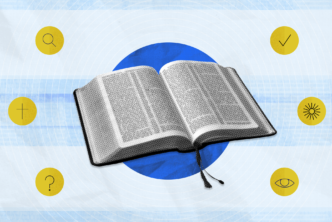Ten years ago, we traveled to the Holy Land. It’s a little humbling now to recognize how much of our precious trip has faded from our memory banks. But the 10-year mark is also a good time to reflect on the abiding value of our tour.
What has stuck with us from our trip to Israel, and how has it helped our Bible study? We’ll tell you.
Our hopes for the trip
Verloyn: I hoped visiting Israel and experiencing it with my five senses would strengthen my faith. I wanted to be better able to put myself in the shoes of so many who faithfully followed the God of the Bible. I also hoped to be impacted by a richer understanding of who Jesus was and what he has done for me by contemplating his life on the soil where he physically lived as fully man and fully God.
Josh: I hoped for a similar experience by visiting Israel: that the sites, sounds, smells and regional experiences would connect the stories I knew to actual places where their events played out. I looked forward to experiencing what some had described to me as reading my Bible in color.
What surprised us in Israel
Verloyn: Throughout the trip, the beautiful and varied topography surprised me, along with the ruggedness of the landscape God chose to use as the tapestry of much of the biblical story. From the agriculturally rich land boasting of sunflower fields as far as you could see, groves of olive trees, and acres of vineyards, to the barren and craggy desert regions around Jericho (the setting of the Good Samaritan parable), to the deep blue Mediterranean Sea stretching out from the sandy beaches off the coastal city of Caesarea Maritima (where the gentile Cornelius first heard and received the gospel), the landscape varied tremendously for such a relatively small space of land.
I was surprised at how often viewing the topography of the land gave me a greater realization of the faith that biblical characters demonstrated to obey God. Trekking through the hot, parched desert near the Dead Sea and Qumran caves left me sympathizing with the Israelites’ 40 year desert journey to the promised land.
Josh: The Sea of Galilee was a lot smaller than I expected. In fact, many of those towns or villages, like Capernaum, where Jesus grew up or later ministered in, were really small—small enough so that one might easily know everyone in them. Though in some sense God hid Jesus away until the time was right (Isa 49:2), in another sense, he did not grow up anonymously. We don’t know much about Jesus’ early life, but these people would have been very aware. It made me think of Jesus’ statement, “a prophet has no honor in his own country.” That long-standing local knowledge of Jesus and his family (as commonfolk and no one particularly extraordinary) became an obstacle for faith for those he grew up with (Matt 13:54–58) and even, initially, his own siblings (John 7:5). Can you imagine the absurdity of someone you’ve known since childhood, now suddenly in his thirties making audacious claims such as “Before Abraham was, I am”?
Bible study insights from our trip
Verloyn: Throughout the trip I followed a simple map of the land, tracked where we were, and marked down the biblical accounts that happened in those locations. Even now when I read my Bible, I have a visual picture in my mind of where a given event took place—and often its proximity to other events. Attached to this as well are the memories of other senses: the smells, sights, sounds, and even sometimes the tastes of those locations. I feel like this was one of my big takeaways from the trip that has made the Bible become more 3D as I read and meditate on Scripture on a daily basis.
Josh: Jeroboam worried that allegiance to his newly formed state would shift away from him and back to Rehoboam if his people continued their regular visits to Jerusalem to worship the Lord as he had prescribed. So he introduced an alternative system of worship that carried strong overtones to Israel’s failure at Sinai. He introduced a new (non-levitical) priesthood, he modified the festival calendar, and he set up golden calves at Dan (near the top of the Northern Kingdom) and Bethel (near the bottom of the Northern Kingdom and a little north of Jerusalem). But how did he convince a nation to follow him in this tragic and blatant apostasy? It seems he appealed to their comfort and the unreasonableness of God’s command:
So the king consulted, and made two golden calves, and he said to them, “It is too much for you to go up to Jerusalem; behold your gods, O Israel, that brought you up from the land of Egypt.” (1 Kgs 12:28, NASB)
I saw for myself (from the comfort of an air-conditioned bus) the arid, treacherous trek that many of Israel’s population would have had to traverse to reach Jerusalem. This stood in stark contrast to the lush, water-fed site up north in Dan where Jeroboam installed one of his two golden calves—leading Israel into generations-long sin. As you read through 1 and 2 Kings, you notice almost two dozen references to the sin(s) of Jeroboam by which he “caused Israel to sin.”
Standing there in Dan, looking at the framed outline where the deviant altar likely stood and pondering the consequences of this route, this lesson pressed on me: my comfort is an insidious guide for worship.
Verloyn: I recall our time at the Sea of Galilee and observing the small ancient fishing boat on display at our Kibbutz (hotel). I picture the disciples and Jesus in that boat, much more fragile and smaller than the boat we rode on while experiencing a sunny, calm day on the sea. In Mark 4:35–41, Jesus tells his disciples to get into the boat, and he falls asleep as a life threatening storm arises. With mere words—“Peace, be still”—the Creator calms his creation. Recalling images in my mind of the entirety of the Sea of Galilee that we viewed high above from the village of Susita gives me a settledness that although I may be in the storm on the boat, Jesus knows the whole picture. He can stop the storm in his followers’ life with a word, but he brings them into that storm to address their fear and faith, to draw them into a deeper relationship with himself, the Son of God.
Josh: Around 700 BC, when a number of countries, including Israel, chose to stop the tribute payments to the Assyrian empire, Assyria brought in their impressive military weight to re-subjugate the nation. Conquering his way through Israel toward Jerusalem, Sennacherib encountered Lachish, an important (and fortified) city in the Southern Kingdom. His siege and conquering of Lachish is depicted in the biblical text (2 Kgs 18; 2 Chr 32), in Sennacherib’s Annals, and on the massive relief made for his palace in Nineveh (which is now housed in the British Museum). These records, along with the archeological findings at that site bear witness to the brutality and horror of Assyrian siege warfare.
Walking among those once blood-soaked ruins helped me catch a greater sense of the dread and fear Hezekiah must have faced hearing of the fall of Lachish and listening to Rabshakeh taunt and intimidate the people of the city of Jerusalem (2 Kgs 18:17–37). Hezekiah had done all he humanly could—up to building an incredible marvel of engineering, a 1,749-foot water tunnel under the city (a tunnel we walked through!). But the siege continued. The vast Assyrian army stood outside Jerusalem’s wall and asked, with an impressive show of force, how Yahweh was any different from all the other gods of the peoples they had already conquered (2 Kgs 18:28–35; 19:10–13). To the human eye, their argument seemed incontestable. And it is at this very point that Hezekiah turned to Yahweh:
Now, O LORD our God, I pray, deliver us from his hand that all the kingdoms of the earth may know that You alone, O LORD, are God. (2 Kgs. 19:19, NASB)
The miraculous account of God’s deliverance of Jerusalem (coupled with the total silence from the Assyrian records of a victory at Jerusalem) testify to God’s unique credentials as the Savior of his people. Though almost 3,000 years removed, standing there in Lachish thinking on these things, I marveled at how the fight is still the same: to believe that the promises of God are more true and weighty than everything else the eye can see.
And yet … seeing the places where God’s mighty arm stretched from heaven to earth was a powerful experience with lasting benefits for our faith and our Bible study.

***
This article was originally published in the May/June 2021 issue of Bible Study Magazine. Slight adjustments, such as title and subheadings, may be the addition of an editor.




